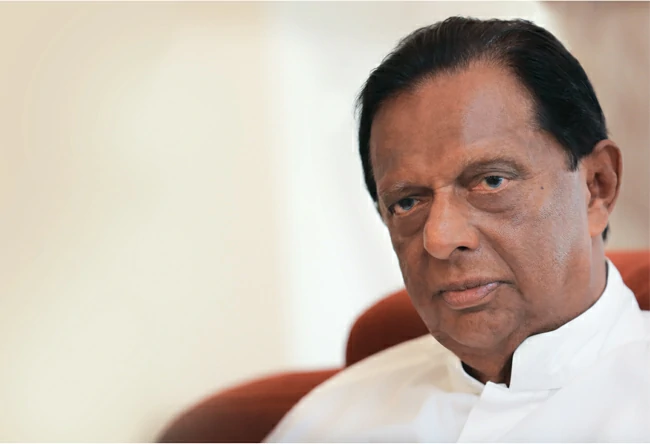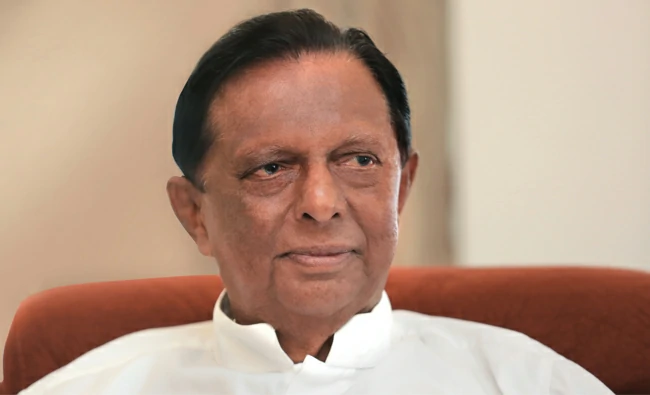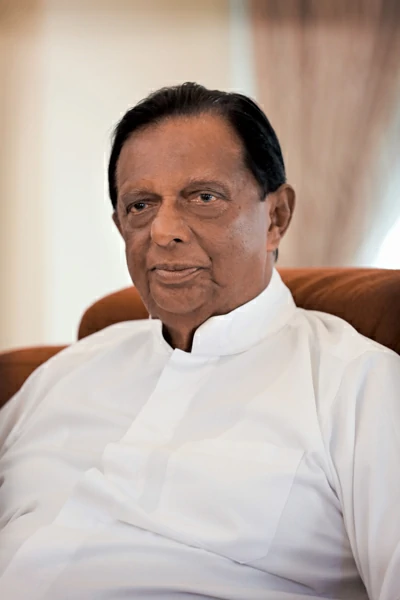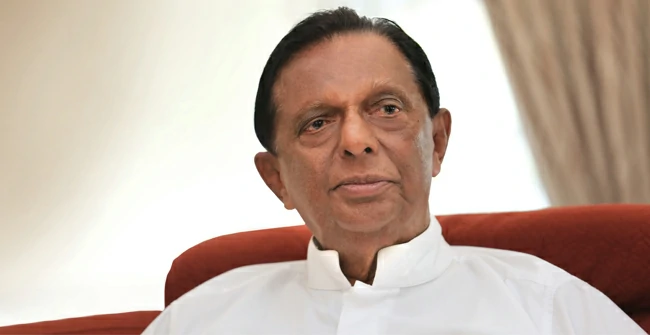
As Minister of Tourism Development and Christian Religious Affairs, John Amaratunga is currently responsible for one of the most important sectors of the economy – tourism. He is the most senior Member of Parliament of the United National Party next to Prime Minister Ranil Wickremesinghe. Minister Amaratunga, a lawyer by training, has over the last 38 years as a Parliamentarian held the positions of Acting Leader of the UNP and Opposition, Acting Minister of Finance and Planning, Minister of State for Foreign Affairs, Minister of Home Affairs and Provincial Councils and Minister of Public Security and Disaster Management. Here, Minister John Amaratunga, explains the government’s plans to showcase Sri Lanka as the ultimate tourist destination, as well as the strategy to attract foreign investment to the tourism sector.
Photography by Mahesh Bandara and Isuru Upeksha
Tourism is an important sector for Sri Lanka. What is the strategy of the government?
In today’s context, tourism per se covers a wide area of economic activity, the scope of which continues to expand on a daily basis. For this reason tourism is now becoming a very important aspect of the Sri Lankan economy. The government is trying everything possible to attract tourists while also working hard to attract investors to the hospitality industry. The tourism business model has changed dramatically in the last couple of years. Let me explain. Today only 50 per cent of travellers use travel agencies; the other 50 per cent use the internet to plan their travel itinerary. They book their accommodation the same way. Earlier the majority of tourists that arrived in Sri Lanka came on packaged tours. Today that percentage is down to as low as 20 per cent. We have to consider these changes when drawing up our promotional plans.
There Is A Master Plan Now Being Formulated By The Ministry Of National Policy And Economic Affairs. The Prime Minister Himself Is Supervising This Process.
In addition, we are also looking at ways and means of bringing all aspects of the tourism industry under one umbrella. This is mainly because of the rise of the informal sector.
Can you elaborate on the strategy to attract investors as well as tourists?
There is a master plan now being formulated by the Ministry of National Policy and Economic Affairs. The Prime Minister himself is supervising this process. Once the plan is ready, we will be able to give more details on the strategy that we will be adopting to reach our target, which is ultimately to make tourism the highest foreign exchange earner for Sri Lanka.
With regard to our strategy of attracting tourists, we first need to find out the profile of our target market.In the past, the majority of tourists that came here were holidaymakers who were above 50 years of age.Today things have changed. We are attracting young adventure-seeking tourists. I understand that at present around 30 per cent of our tourists are in the 20 to 29 age range. This is a vast change from the tourists we were used to catering to. New products and services to cater to this emerging trend have to be introduced.
The other thing is that the majority of these travellers make bookings on impulse. That is to say that they do not make their travel plans months in advance but a month ahead at the most.
As part of our strategy, we would like to move away from the ‘seasons’ concept. We should not market the east coast and the west coast separately based on the monsoon seasons. Instead it is Destination Sri Lanka that should be marketed. This is because the east coast is now open for business and some of the best hotels in this country can be found in that region where the sun shines almost 365 days of the year.
As for our strategy to attract investors to the tourism sector, a host of incentives were offered to prospective investors in the leisure, hospitality and tourism sectors in the last budget.In addition, the government is very focused on improving the country rating on the ‘ease of doing business index’. Our target is to move into the ’50s’ range in the short to mid-term. The world around us is in turmoil and Sri Lanka is today one of the most peaceful places on earth. With the stability the new unity government has to offer, the fundamentals are in place to attract investment. We are also in the process of turning the entire western province into a megapolis.We estimate that this megapolis will be home to millions of people and will be the most liveable city in South Asia.It will be the biggest city between Singapore and Dubai. The Port City is a part of this plan. It will have its own special financial and business districts complete with international hotels and tourism services. The opportunity for investment in all this is unprecedented.
In addition to the government’s special focus on tourism, we are planning to develop new tourism zones across the country. Some of the new areas we have earmarked for development include Kalpitiya in the north western coast, Jaffna in the north, Passekudah and Arugam Bay in the east and Mirissa in the south of the island. The opportunities for investment, especially in the tourism sector, are unprecedented.
In terms of employment, the government aims to create 350,000 tourism-related jobs by 2020.Can you elaborate on the training and skills development that has been planned?
At the moment we are going ahead with the formal training process that has been in existence. We are also in the process of formulating crash-training programmes. They are being conducted across all cities, particularly in areas where there is a concentration of tourist hotels.Since I assumed office, we have already opened hospitality training centres in Hambantota, Passekudah and Negombo.
The demand for trained personnel is such that the entire first batch that passed out from the Hambantota school recently was employed by the industry in a matter of days. I have also instructed the Sri Lanka Institute of Tourism and Hotel Management, which comes under my purview, to introduce short courses so that the output can be maximised, and to deliver the training and certification programmes where there is a higher concentration of hotels without centring all their efforts in the Western Province. It has been estimated that the hospitality industry alone will require 130,000 new recruits in the next four years. The requirement of trained employees in the upcoming new hotels should be met by the Sri Lanka Institute of Tourism and Hotel Management (SLITHM) launching improved curriculum and training programmes and increasing the intake in consultation with the TVET sector. SLITHM curriculum also needs to be offered through other institutions and that would require the government to strengthen the institution. The large hotel groups would, however, manage their manpower requirements through their internally-generated training programmes. For them, also, tourists’ expectations are something they will need to train their staff for as the tourism numbers increase, and that element is what will make the difference between a good and a great experience.
I am confident we can get our young people trained up to meet the human resources demands of the industry.
Sri Lanka aims to attract four million tourists by 2020. How will this be achieved?
I think this year, particularly the month of January, has been very promising. Hotels were at full capacity in both January and February, so this shows the world is looking at Sri Lanka. Travel agencies across the world are promoting Sri Lanka as a destination. On the other hand, many countries are facing problems such as the fighting in the Middle East, tensions in Central Europe, and disease. Against this backdrop, Sri Lanka seems to be the only safe place to visit at the moment.
But we are not banking on others’ misfortunes alone to attract tourists. We are about to launch an aggressive digital campaign that seeks to target the global tourist. As I said before, the old model is changing: today, social media rules. We are launching various multi-pronged, target-specific campaigns especially to lure Chinese and Indian tourists, who already are our two biggest source markets.Sri Lanka, with its sunny weather and beaches, can customise a niche offering. Another factor is that tourists have a greater confidence in a destination when they recognise familiar brands, and brand names such as Shangri-La, ICT and Hyatt when they start their operations will add value and diversity to the portfolio of star-class hotels.
You have mentioned previously that Sri Lanka is aiming for high-end tourists. Is the country ready for high-end tourists? Are we targeting the right market?
Yes, I believe we are ready. It is more beneficial to have high-end tourists. It’s not the numbers but the spending power that matters to the Sri Lankan economy. Already many luxury hotel brands have set up operations and according to reports these hotels are fully booked.Sri Lanka as a destination is a unique product proposition that few can rival. Unfortunately, due to the war, we undersold our product just to survive. This scenario is now changing where Sri Lanka is getting fair value for the product on offer.
By March There Will Be An Addition Of About 500 Or More Rooms To The Tourism Sector. Our Aim Is To Build An Inventory Of 45,000 Rooms By The End Of 2020.
As Sri Lanka aims to target high-end tourists, what are your thoughts about the number of rooms and infrastructure for tourists?
A number of new hotels are coming up, with capacities of 300 to even 600 rooms. By March there will be an addition of about 500 or more rooms to the tourism sector. Our aim is to build an inventory of 45,000 rooms by the end of 2020.
There is also a misconception that high-end tourism means having ultra-luxury hotels. That is only one aspect of it. Discerning tourists are willing to pay vast amounts just to have a particular experience – maybe for a particular location, service or even to savour a particular meal. It is up to the industry to create these so-called high-end products and there surely will be takers. Tea Trails is one such product.
What I’m saying is other than bricks and mortar, there has to be out-of-the-box thinking to sell experiences. Sports events such as golfing, sailing/yachting and even horse racing have the potential to attract high spenders.
As for developing infrastructure we have already got the ball rolling in the new tourism zones in Passekudah and Kalpitiya, both of which I have been personally supervising. Steps are being taken to increase the number of flights into Sri Lanka from 70 to 150 a day. The existing airports will be developed to make internal travel easier. We are also looking at constructing convention centres capable of holding more than 20,000, with all-modern facilities to cater for conferences and exhibitions and also for tourists to enjoy a wider shopping experience.
What are the main markets that Sri Lanka is focusing on?
At the moment we are looking at the Indian and Chinese markets, which are two relatively new markets.The arrival figures from these countries are very promising. Of course, there are also the traditional European markets, but I think the new markets are something we should explore, because India and China have the potential to bring in a lot of high-end tourists, the point here being that a substantial share of wealth lies in the hands of both India and China’s younger population, which implies that this segment must be a key focus group.
What are you doing to promote Sri Lanka tourism overseas?
We participate in all the trade fairs and conventions taking place across the world. Showcasing Sri Lanka to the world is the number one priority. At the same time, we are also planning a tour agents’ convention in Sri Lanka, to bring tour agents from across the world to Sri Lanka, and as I said earlier, most importantly we are launching a digital campaign across all social media and Google. We will also make our presence felt on many digital platforms and touch points across the globe, one such being on inflight content.
Sri Lanka is still focusing on its traditional attractions such as history, wildlife, and beaches to attract tourists, but there is nothing for tourists in the main cities in terms of products and entertainment.What are your thoughts on this and what is being done to address this?
That matter has been seriously addressed in our plans. The master plan that is now being formulated will come up with proposals on how to organise events both in Colombo and other urban areas. For example, our plans include inviting popular artistes to perform in Sri Lanka on a regular basis. There will be many other such opportunities.
We are also venturing into new avenues such as event-based tourism, tourism based on calendar events, MICE tourism, sports tourism, health and medical tourism. The homestay programmes we have initiated are designed to allow tourists to obtain a flavour of our culture as well as our unique lifestyles. The tremendous diversity of Sri Lanka’s culture has much to offer; therefore, we must strive to make Sri Lanka a destination country of choice.
What are the plans for Kalpitiya?
Kalpitiya is a very promising place. We are going to declare it as a special tourism zone. There is a huge demand from investors to set up hotels and restaurants here. The biggest attraction in Kalpitiya is the whale and dolphin watching seasons. Surfing and kite surfing are increasing in popularity while its proximity to the Wilpattu National Park will be exploited through a direct connection via boat so that Kalpitiya can be a standalone tourist destination.
In terms of cuisine, Kalpitiya produces the best catch of crabs in the whole world. They are even exported to Singapore and Malaysia, where there is a high demand for it. There’s no better place for seafood really.
Is there more investment coming to Kalpitiya?
Yes. Thus far, at least four parties have shown interest in the islands off Kalpitiya. Some have even paid deposits some time ago; however, approval procedures were delayed. As a result, they have not been able to get these investments off the ground, but they will be finalised soon. An exciting new development is a project by a Maldivian entrepreneur who will soon transform one of the islands off Kalpitiya into a Maldivian-type water bungalow hotel. This luxury hotel project is expected to take our resort sector to the next level.
Has the government earmarked any other areas for tourism projects?
Several areas have been identified. These include Buddhist sacred sites, heritage sites, agro-tourism and the tea industry. Sri Lanka hosts an array of places to suit the different interests of a variety of people. Jaffna and Mannar islands, Yala, and Kalpitiya would be developed on a priority basis as well as the Passekudah National Holiday Resort. The Southern area of Bentota has been earmarked for a model beach development.
Sri Lanka has competition within the region, as there are many places where tourists can have a great experience at a lesser cost.Is Sri Lanka providing value for money to tourists?
I don’t agree that the competition is better value. In Northern India, for example, you can’t get a room for less than 300-400 dollars. We cater to all budgets, from backpackers to the high-end tourist. Even when it comes to food outlets, we have our buth kades right next to five-star hotels. One can easily be spoilt for choice. So how can Sri Lanka not be value for money?
What are your plans for the Eastern Province?
The Eastern Province is developing rapidly, particularly Nilaveli. All the land in the area has been snapped up due to the attraction of the Nilaveli sea and beach. Meanwhile places such as Passekudah and Arugam Bay are growing in popularity. I have already spoken about some of the plans.
You are also the Minister of Christian Affairs. Can you tell us what this entails?
I am the Minister of Christian Affairs, and as such I have to watch the interests of the entire Christian community in the country. Of course, the Roman Catholic Church is the most prominent body, but there are other denominations and churches.
You are the second most senior minister in the UNP and have stood by the Party through thick and thin. Can you tell us about yourself and your political journey?
I entered Parliament in 1978. I have now completed 38 years in Parliament, as a member of the UNP. I have worked with three presidents and with the current leader. We have had many challenges while in opposition. As a senior, I stood by the Party and the UNP Leader during a very difficult period for the Party. Our Party is strong now, we must build on our strengths and recognise the people who have stood by the Party over the years. We have a good leader in Prime Minister Ranil Wickremesinghe; there is, however need for greater engagement and he must now reach out to ordinary people and clearly explain the difficulties not only in regard to our economic challenges but also the constitutional reform process.
The People Of Sri Lanka Have To Be Patient…Internationally We Are Now Recognised As A Government, Which Respects Human Rights. We Have A National Quest That Is Focused On Developing The Country And Increasing The Income Of Our People..
Final thoughts?
The beginning of the present government was when President Maithripala Sirisena was chosen as the presidential candidate. He is one of the most humble presidents the country has elected, so much so that he is willing to relinquish his power after his term. He is also very keen on good governance.The theme of the government is, “Ensuring good governance in Sri Lanka.” Human rights and democratic principles are all part of the government’s principles. The 19th amendment was a big victory for good governance.
The people of Sri Lanka have to be patient. The present government is trying to undo the wrongs committed in the past. Internationally we are now recognised as a government, which respects human rights. Now we have a national quest that is focused on developing the country and increasing the income of our people. There needs to be a proper plan for this quest.We are in the process of formulating it. The upward surge in tourism, for example, reflects this new sense of freedom and optimism.








